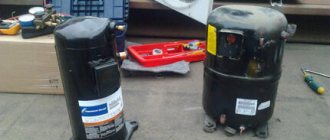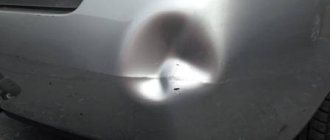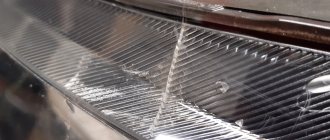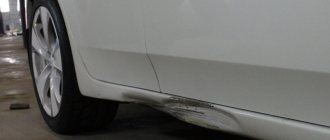Compressor repair is the most difficult and expensive among car air conditioner repairs.
In addition to the fact that the compressor itself is not cheap, its price varies from 700 to 900 dollars (for foreign cars), the repair itself is usually accompanied by other additional expensive work.
Such work may include: replacing a thermostatic valve, flushing the entire air conditioning system, installing a new receiver-dryer and other work.
It is clear that monitoring the technical condition of the compressor is necessary constantly. We’ll look at how to do this and what you need to pay attention to next.
By eliminating a minor breakdown, you can prevent a major breakdown, and this is a significant cost savings.
Design and principle of operation
An air conditioner is a rather complex closed-loop system.
In order to understand how it works, it’s worth first considering each element separately:
- The compressor is the most complex element of the system. First of all, it is designed to compress the refrigerant and turn it into a high-temperature gas. The operation of the car air conditioning compressor is ensured by a belt through an electromagnetic clutch.
- A condenser - or, to put it more simply - an aluminum radiator of an air conditioner, it is inside it that the gas is converted into a liquid substance. As a rule, the radiator is equipped with electric fans that provide temperature regulation through airflow. Additionally, it is worth noting that the radiator is one of the most vulnerable parts of the entire system. It not only does not tolerate various types of mechanical stress well, but can also fail simply as a result of intensive use.
- Evaporator. It is an aluminum heat exchanger in which the refrigerant is converted from liquid to gaseous. The evaporator is located directly in the vehicle interior in the same place where the heater radiator is located.
- Expansion valve. A small but very important element, which directly determines how much refrigerant enters the evaporator and, therefore, the performance of the system as a whole will depend on this valve. To put it simply, this small valve is responsible for the temperature in the cabin.
- In some cases, instead of an expansion valve, an expansion tube can be used, which essentially performs the same task, but has a slightly different design. The use of an expansion valve or expansion tube depends solely on the design of the particular system.
- If an expansion tube is used in the car air conditioning system, the design will also contain a so-called accumulator-drier, which performs the function of drying and filtering the refrigerant.
The cost of replacing a car air conditioning compressor is approximately 3-5 thousand rubles.
The car air conditioning system provides two ways to control the air temperature in the cabin:
- Manual control, in which the driver manually changes the air temperature in the cabin using special controls. At the same time, the process of operation of the air conditioner will be influenced by quite a lot of factors, such as the speed of the car, the ambient temperature, the speed at which the engine operates, etc.
- An automatic control system is considered more advanced. It is necessary to set the desired temperature in the control unit, and then the electronics itself will adapt to the driver’s requirements. To do this, the automatic system is equipped with several temperature sensors, an electronic control unit, as well as a number of rather complex dampers, valves, etc.
Diagnosing the electromagnetic clutch
Self-repair of the air conditioning compressor can also be done to repair the electromagnetic clutch. Inspection of this part includes checking for the presence of lubricant on the rotor and pressure plate. The clutch bearing must be free of lubricant leaks. Use a meter to determine the coil resistance. The coil resistance should vary between 3.15-3.45 at t 20 C. If the indicator is non-standard, it must be replaced with a new part. The last step is to measure the gap between the pulley and the clutch disc. If it deviates from the norm, the magnetic field will not be able to press the coupling to the pulley. The range should be between 0.35-0.65 mm.
How to properly check the operation of the compressor
It is best to entrust the operation of a car air conditioner to professionals; when diagnosing it yourself, you should pay attention to the presence of extraneous sounds and odors.
As for deeper diagnostics, it is carried out in the following order:
- First of all, the system is checked when operating in normal mode; it is necessary to check how the temperature in the cabin changes when the settings are changed, thus sometimes obvious malfunctions of the controls can be identified.
- Another fairly effective method is a banal visual inspection, and attention should be paid not only to the compressor, but also to all other parts of the system, and in particular, pipes, hoses, radiators, etc.
- A very important point is to measure the pressure inside the air conditioning system, and it needs to be checked both in the off and in the operating state.
Features of the cooling system
Cooling the air inside a closed machine becomes possible in the following way. When a compressor, which has several special pistons, reduces the volume of refrigerant and converts it into liquid. The liquid spreads freely throughout the entire car air conditioning system and causes it to reduce the temperature in the cabin to the specified values. To avoid having to frequently repair the car air conditioning compressor, moving parts must be treated with a special lubricant.
This is interesting: Car alarm “Sheriff”: 7 system models and detailed operating instructions
Signs of trouble
The most common signs of malfunctions in the car air conditioning system are:
- Constant monotonous noise, and it can be heard even if the air conditioning is not working, but the engine is running. When the air conditioner is turned on, the nature of the hum changes in one direction or another. This sign indicates that it is time to replace the bearing on the compressor pulley.
- Another fairly common malfunction is a situation where, for some reason, the electromagnetic clutch does not turn on.
- Refrigerant leaks from the system, significantly reducing system efficiency.
- Extraneous noise when the air conditioner is running, in particular, we are talking about humming, knocking, characteristic “rumbling”, etc. In this case, quite significant pressure drops can be recorded in the system.
Preventive inspection and replacement of the drive pulley bearing
If you hear a noise in the bowels of the car when operating the compressor, it means it’s time to inspect the bearing. Noises of unknown origin may also appear when the air conditioner is not working, when the shaft is idling. The car may hum due to a tightened drive belt, or due to complete wear of the air conditioning compressor bearing after its service life has expired.
The first step towards correcting this problem will be to check the main elements of this system, including inspecting the air conditioning compressor pulley. Carefully inspect the shaft drive belt. After stopping the engine, turn off the electromagnetic clutch, then turn the shaft. The hand force when turning should be noticeable. If the turn is tighter than usual, loosen the belt. In case of repeated failure, we replace the shaft bearing.
Possible causes of air conditioning compressor failure
- Compressor pulley bearing failure most often occurs due to simple wear. It is worth noting that this malfunction is very dangerous; if the bearing stops functioning correctly, there is a high probability that due to the increased load the electromagnetic coil will also fail. This also leads to pulley misalignment and possible refrigerant leakage.
- If the electromagnetic clutch does not work, then most likely it has simply failed due to overheating of the compressor. Also, on budget models, there may be a factory defect in the element. And, of course, we cannot exclude normal wear and tear associated with time and active use. The good news is that repairing this fault does not cause any big problems and can be done with fairly simple tools. In addition, the components in this case will be quite cheap.
- A leak in the car air conditioning system can be caused by damage to the housing parts or pipes. In the first case, it is highly not recommended to carry out repairs yourself; it would be more reasonable to turn to professionals who can repair the compressor. Well, replacing the connecting pipes of the air conditioner is much easier.
- The reason for the appearance of extraneous noise during operation of the air conditioner, as a rule, is the wear and tear of the working surfaces; pressure drops in the system are also explained by the failure of one or more valves responsible for the supply of refrigerant. The cause of failure is gradual wear of the system or a lack or excess of refrigerant. It is also worth checking the radiator for clogging, however, this is almost impossible to do at home.
Diagnostics
To check the performance of the system with your own hands, just first turn on the cooler by pressing the button. It would be a good idea to check the switch itself, since sometimes it is because of its malfunction that the entire unit does not work.
If the button works, but nothing turns on, or cold air does not flow into the cabin, then the air conditioner is definitely faulty. We'll have to move on to the engine compartment. First, take a look at the condition of all the tubes and check that the radiator is working properly. If oil stains are found on these components, this indicates a freon leak. This causes the compressor to automatically turn off and nothing to work. Leakage occurs due to vibrations, as the connections of the pipes gradually weaken and the refrigerant begins to leak out. Here you need to determine where exactly the problem occurred. This can be done by pumping in a small amount of coolant.
Another breakdown may be related to the electromagnetic clutch. If, when you press the air conditioner activation button, there is no characteristic click that would confirm the engagement of the clutch with the pulley, or a grinding noise appears with the parallel appearance of a burnt smell, the bearing has come to an end. This involves replacing the coupling.
There are several main components that can cause system failure:
- pipes and hoses;
- coupling;
- compressor;
- radiator.
Let's talk about them separately.
But first, let me remind you that refilling the air conditioner is a potentially dangerous procedure. However, it must be carried out every 2 years on a new car. If the car is more than 5-6 years old, then refueling is performed annually.
coupling
We'll start with the coupling. In almost any city, be it Moscow, St. Petersburg, Tver, Volgograd, Omsk, Lipetsk, and in Minsk too, there are many car service centers offering professional service for car air conditioners. One of the tasks they perform is replacing the A/C clutch.
see also
Semi-automatic mode of connecting the body to the engine, the new Niva and other upgrades from AvtoVAZ
Regardless of what type of air conditioner is used on the vehicle, the electromagnetic clutch is a mandatory element of the design of the interior cooling system. The purpose of the coupling is to connect the air conditioner shaft directly to the drive pulley. Drive couplings come in several types. This is important because the appropriate lubricating oil is used for each. Keep this in mind when doing maintenance and repairs yourself. Add the correct oil.
When the motor is running, the clutch rotates constantly due to the engine belt. When the condenser is turned on, the clutch clicks and engages the compressor shaft.
If there is no click, but extraneous noise appears, there are probably problems with this unit. But there is a more unpleasant situation.
It is connected with the fact that often there are no external or audible signs that the coupling has failed and has lost its functionality. But the rotational motion is still not transmitted to the compressor. In this situation, it is no longer possible to do without professional help, since you will need to use special equipment. There is no point in buying it for personal use. But in service centers it is. And the cost of diagnostics is low. Although another point speaks in favor of the coupling.
This unit has a reliable and durable design. Therefore, the clutch, when compared with other air conditioner components, fails much less often. The replacement procedure is simple, you can do it yourself.
Radiator
The radiator usually needs to be cleaned and restored after mechanical damage. Repair will only make sense in a situation where depressurization has not occurred and the unit has not been subjected to the destructive effects of corrosion.
see also
Frozen gas tank flap: how to open, preventive measures
Only radiators with minor mechanical damage can be restored. First, it is dismantled, after which the conventional spraying method, or the more effective argon-arc welding, is used. It is unlikely that you will be able to perform such tasks at the highest level with your own hands, without experience, skills and special equipment. After welding, the radiator is checked for leaks, creating an internal pressure of 20 atmospheres.
Sometimes radiators leak because corrosion has caused the leak. There is no point in talking about restoration here. You need to buy a new unit.
Compressor
It fails if installed incorrectly or if operating conditions are violated.
Quite often you can encounter this situation. When contacting a car service center, technicians notice traces of freon leakage or darkened thermal insulation. In the end, they only fix these problems. Plus, they refill the air conditioner, install filters, and clean the system. But in fact, this does not particularly affect the condition of the unit, as a result of which the air conditioner soon stops working again. The compressor is rightly called the main element of the system. Therefore, if it breaks down, diagnostics must be carried out followed by repair or replacement.
The compressor can be saved if there is moisture inside the system, or if the tightness of the hose and pipeline is broken. The essence of restoration is flushing the system. Next is vacuuming and full refueling.
But if the compressor has failed and can no longer be repaired, then the only option is replacement.
Tubes and hoses
Most pipes in air conditioners are made of aluminum. But they can still gradually collapse.
This is due to the influence of:
- temperature changes;
- reagents on winter roads;
- accumulating pollution, etc.
Gradually the tubes oxidize and then rot. The repair procedure is similar to that used for the radiator. If the wear is severe, then a complete replacement is performed.
Repair of major faults
If any malfunctions are identified in the operation of the system, then, naturally, they will need to be eliminated as quickly as possible.
In some situations you can do this yourself:
- If any mechanical damage to the compressor housing is detected, it will be possible to eliminate them using a welding machine.
- When replacing the oil seal or gaskets, you will first need to remove the refrigerant from the system and remove the compressor from the vehicle.
- In order to replace the pulley bearing, you will also need to remove the compressor. Next, the bearing is removed and a new one is pressed in its place.
- Repair of an electromagnetic clutch involves replacing failed elements, in particular, a pressure plate, a burnt coil or pulley, it all depends on which part was subject to wear.
- It is quite difficult to eliminate malfunctions of the piston group with your own hands, since this will require completely disassembling the compressor. Therefore, the wise decision would be to seek the help of professionals.
Air conditioning in a car is a very convenient and practical thing. In order to ensure uninterrupted operation of the system, you should carefully monitor its performance and condition, because repairs are sometimes quite expensive.
Air conditioner design
You cannot repair the air conditioning compressor in a car yourself without knowing the principle of its structure. A car air conditioner is a complex design that includes:
- Compressor . The main part that ensures the flow of coolant to the radiator.
- Radiator . Promotes timely cooling of the refrigerant. Due to the fact that a car radiator is located near it, the air flow that occurs while the car is moving helps to further reduce the temperature.
- Fan. Cools the refrigerant to a certain temperature.
- Receiver. Responsible for filtering condensate from dirt and dust particles.
- Thermostatic valve. Through it, the condensate, which has turned into a gaseous state, is transported to the evaporation device.
- Evaporation device. Using a fan, it allows the cooled refrigerant to enter the car interior.
Another important part is the electric coupling. It is necessary so that after starting the car air conditioner, the pressure pulleys are tightly connected to the disk driven by the drive belt. When the electric coupling breaks, the car owner has to repair the air conditioning compressor.
"Lacetti"
So, how is an element replaced here? The first step is to bleed off the refrigerant. Then remove the drive belt. Next, release the clamps and disconnect the wires from the electromagnetic coupling. Then unscrew the nut securing the plate with the hose block, disconnect the pipeline flanges, and plug the holes. Then remove the lower and upper bolts securing the device to the engine.
This is how the air conditioning compressor is replaced on a Lacetti. As you can see, there is nothing complicated.
Piston compressor
The main part of this unit is the piston. There may be several of them in the compressor. Their number depends on which company the product is from. The pistons can be installed in a V-shape or in one plane. Placing the pistons crosswise is also less common.
As discussed above, the main function of the compressor in the system is to compress freon or other refrigerant. Due to compression, freon will begin to circulate along the line from an area where high pressure prevails to an area with low pressure.
"Nissan"
Replacing the Nissan air conditioning compressor is performed as follows. The first step is to remove the belt from the auxiliary drive. Next, dismantle the engine protection. Before disconnecting the pipeline, it is necessary to bleed off the freon. This can be done through special low and high pressure valves. To remove refrigerant from the system, press on the valve stems.
Next, use a 10mm socket to unscrew the two bolts and remove the tubes from the compressor cover. Then you need to disconnect the wire tip from the electromagnetic coupling. Using the same head, unscrew the two bolts that secure the hose bracket. Then it remains to unscrew the bolts securing the compressor to the engine. The mechanism can then be removed. The new one is installed in place of the old one, and everything is assembled in the reverse order.
The air conditioning compressor is replaced with a Renault in the same way - the designs are the same, because they are the same automaker. Before installing a new compressor, it is worth replacing the sealing elements.











